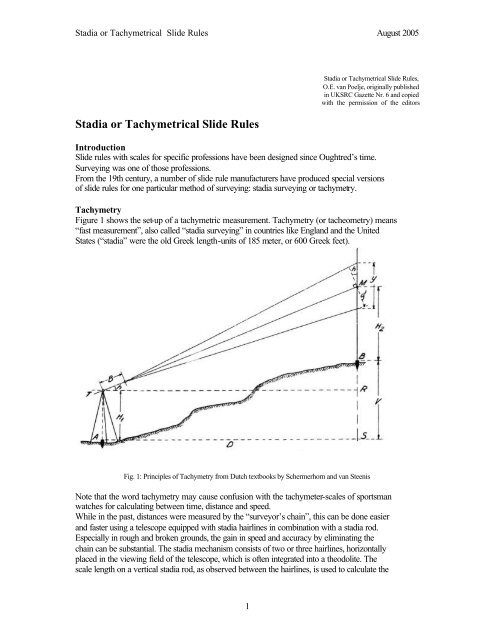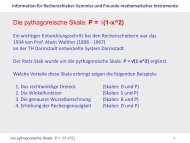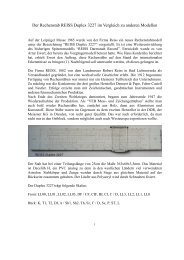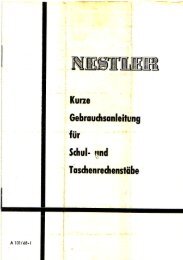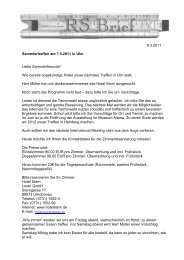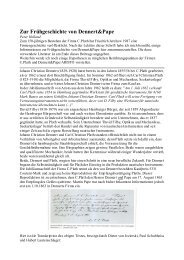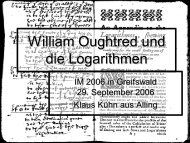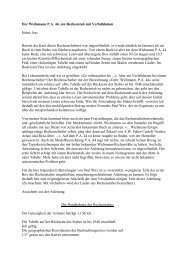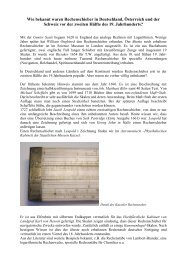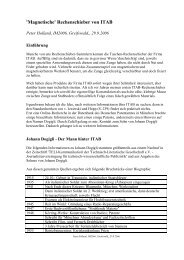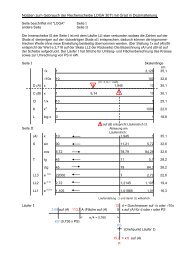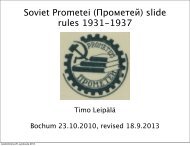Stadia or Tachymetrical Slide Rules - Rechenschieber.org
Stadia or Tachymetrical Slide Rules - Rechenschieber.org
Stadia or Tachymetrical Slide Rules - Rechenschieber.org
Create successful ePaper yourself
Turn your PDF publications into a flip-book with our unique Google optimized e-Paper software.
<strong>Stadia</strong> <strong>or</strong> <strong>Tachymetrical</strong> <strong>Slide</strong> <strong>Rules</strong> August 2005<br />
<strong>Stadia</strong> <strong>or</strong> <strong>Tachymetrical</strong> <strong>Slide</strong> <strong>Rules</strong><br />
<strong>Stadia</strong> <strong>or</strong> <strong>Tachymetrical</strong> <strong>Slide</strong> <strong>Rules</strong>,<br />
O.E. van Poelje, <strong>or</strong>iginally published<br />
in UKSRC Gazette Nr. 6 and copied<br />
with the permission of the edit<strong>or</strong>s<br />
Introduction<br />
<strong>Slide</strong> rules with scales f<strong>or</strong> specific professions have been designed since Oughtred’s time.<br />
Surveying was one of those professions.<br />
From the 19th century, a number of slide rule manufacturers have produced special versions<br />
of slide rules f<strong>or</strong> one particular method of surveying: stadia surveying <strong>or</strong> tachymetry.<br />
Tachymetry<br />
Figure 1 shows the set-up of a tachymetric measurement. Tachymetry (<strong>or</strong> tacheometry) means<br />
“fast measurement”, also called “stadia surveying” in countries like England and the United<br />
States (“stadia” were the old Greek length-units of 185 meter, <strong>or</strong> 600 Greek feet).<br />
Fig. 1: Principles of Tachymetry from Dutch textbooks by Schermerh<strong>or</strong>n and van Steenis<br />
Note that the w<strong>or</strong>d tachymetry may cause confusion with the tachymeter-scales of sp<strong>or</strong>tsman<br />
watches f<strong>or</strong> calculating between time, distance and speed.<br />
While in the past, distances were measured by the “survey<strong>or</strong>’s chain”, this can be done easier<br />
and faster using a telescope equipped with stadia hairlines in combination with a stadia rod.<br />
Especially in rough and broken grounds, the gain in speed and accuracy by eliminating the<br />
chain can be substantial. The stadia mechanism consists of two <strong>or</strong> three hairlines, h<strong>or</strong>izontally<br />
placed in the viewing field of the telescope, which is often integrated into a theodolite. The<br />
scale length on a vertical stadia rod, as observed between the hairlines, is used to calculate the<br />
1
<strong>Stadia</strong> <strong>or</strong> <strong>Tachymetrical</strong> <strong>Slide</strong> <strong>Rules</strong> August 2005<br />
distance to the rod. The principle of the stadia hairlines was already known about the end of<br />
the 17th century, but James Watt was one of the first who applied this method in 1790, during<br />
his field surveying f<strong>or</strong> the construction of the Crinan canal in Scotland.<br />
The calculations in stadia surveying involve c<strong>or</strong>rections in case the measuring<br />
direction TM in figure 1 is not h<strong>or</strong>izontal (which can happen even in level Holland). In that<br />
case the following approximations can be derived from the figure, see [1]:<br />
H<strong>or</strong>izontal Distance: D = A . y . cos 2 (h) (1)<br />
Vertical Distance 1 : V = A . y . sin(h) . cos(h) (2)<br />
V can be expressed in D: V = D . tan(h) (3)<br />
with:<br />
A =<br />
y =<br />
h =<br />
Multiplication fact<strong>or</strong> of the stadia mechanism, in most cases set to 100, but f<strong>or</strong> large<br />
area surveys in the USA set to 200<br />
Scale length on the vertical stadia rod, as observed between the hairlines<br />
The angle of elevation of the telescope<br />
The occurrence of a second “cosine” function in these f<strong>or</strong>mulae is caused by the fact that the<br />
observed distance is not measured c<strong>or</strong>rectly, because the rod stands vertically (see y), and not<br />
perpendicular to TM (see y¹).<br />
These c<strong>or</strong>rections from measured distance to h<strong>or</strong>izontal and vertical distance (D and V<br />
respectively) were also called “reductions”. They could be calculated in different ways.<br />
The highest precision was achieved with stadia reduction tables, but those were not very<br />
convenient when w<strong>or</strong>king outside. They were mostly used back in the office to produce<br />
terrain maps from a large number of field measurements.<br />
Nomograms have also been used f<strong>or</strong> reduction calculations.<br />
<strong>Slide</strong> rules were less precise, but easier to use and m<strong>or</strong>e resistent to the weather, especially the<br />
versions in stainless steel <strong>or</strong> other non-magnetic metals.<br />
The continuing development of self-reducing tachymeters, like the Redta from Zeiss and the<br />
RDH from Wild, and the m<strong>or</strong>e modern optical distance meters, eventually made the manual<br />
reductions in stadia surveying redundant.<br />
<strong>Slide</strong> rules f<strong>or</strong> <strong>Stadia</strong> Surveying<br />
Most slide rules in the 20 th century, and even long bef<strong>or</strong>e, did have sine and tangent scales,<br />
see figure 2 from the “<strong>Slide</strong> Rule Catalogue” [2].<br />
Fig. 2: Sine and tangent scales on the back of a simple slide rule (type Rietz)<br />
1 F<strong>or</strong>mula (2) actually has to be c<strong>or</strong>rected f<strong>or</strong> height of telescope and of rod centre by adding H 1 – H 2<br />
2
<strong>Stadia</strong> <strong>or</strong> <strong>Tachymetrical</strong> <strong>Slide</strong> <strong>Rules</strong> August 2005<br />
In the usual notation f<strong>or</strong> scales in the SR Catalogue, where the = sign indicates the edge<br />
between body and slide, the Rietz scales can be described as<br />
front: K A = B CI C = D L, back: = S ST T =<br />
The “backward” position of the sine scale on generic slide rules made trig calculations<br />
cumbersome, while the product of sine and cosine, required in f<strong>or</strong>mula (1), could not be done<br />
without writing down an intermediate result.<br />
So it is not surprising that a need existed f<strong>or</strong> specialised slide rules to calculate the<br />
sin.cos- and the cos 2 -functies in stadia surveying. <strong>Stadia</strong> rules can often be recognised by the<br />
scale namings sin.cos and cos 2 . In stead of sin.cos, an equivalent f<strong>or</strong>mula was sometimes<br />
used: ½ sin (2a), especially in the USA.<br />
Table 1 gives an overview of some stadia slide rules which have been produced, with<br />
inf<strong>or</strong>mation like <strong>or</strong>iginating country, and special f<strong>or</strong>m <strong>or</strong> dimensions. F<strong>or</strong> 19th century rules,<br />
the year of introduction is given <strong>or</strong> estimated. This inf<strong>or</strong>mation has been distilled from various<br />
collections, manuals and brochures.<br />
Many stadia rules had both a sexagesimal (360°) and a centesimal (400 gon, also written as<br />
400° of 400 g ) version. Anglo-Saxon brands were often restricted to sexagesimal versions.<br />
Geodetical slide rules without stadia scales have been omitted from table 1.<br />
Undoubtedly there are many m<strong>or</strong>e brands and types of stadia slide rules.<br />
COUNTRY BRAND TYPE<br />
China Sjanghai Flying Fish nr. 1005<br />
Denmark DIWA Topographical 231 (360°), 241 (400 g )<br />
England Stanley Fuller Bakewell Type 3 (cylinder with spiraling scales,<br />
1879)<br />
France H. M<strong>or</strong>in [4] No type indication (400°, German Silver, 40 cm, ˜ 1860)<br />
Graphoplex Géomètre Topographe 630 (400 g )<br />
Tavernier Gravet ”Règle Moinot” nr. 20<br />
Germany Aristo Tachymeter 23 (System C. Werner, Vienna, since 1898)<br />
Universal-Tachymeter 24<br />
Schweizer Topograph 44<br />
Universal 48<br />
GEODÄT 958, 0958<br />
<strong>Stadia</strong> Computer 680 (disc Ø 15 cm)<br />
Faber - Castell<br />
Nestler<br />
Reiss System Seiffert 1145<br />
Japan Sun - Hemmi <strong>Stadia</strong> 2690 (bamboo)<br />
Civil 269 (bamboo)<br />
Concise<br />
Tachymeter 1/38, 111/38, 4/38 (50 cm), 67/38 (12.5 cm)<br />
9a (Spain, German Silver, 40 cm)<br />
Universal 28<br />
Geometer 280 (360°), 281 (400 g ), 285 & 286 (50 cm)<br />
<strong>Stadia</strong> Computer, still f<strong>or</strong> sale in 2005! (disc Ø 9.6 cm)<br />
3
<strong>Stadia</strong> <strong>or</strong> <strong>Tachymetrical</strong> <strong>Slide</strong> <strong>Rules</strong> August 2005<br />
Netherlands Matthijssen [5] 1) Nr. 170<br />
2) No type indication<br />
Switzerland Kern (Aarau) [3] No type indication (German Silver, 22 cm, bef<strong>or</strong>e 1880)<br />
Loga<br />
1) Topo 6400 A‰ (military disc in 6400 mils, Ø 12.6 cm)<br />
2) 30 Tt (400°, Ø 12.6 cm)<br />
USA Gurley Cox’s <strong>Stadia</strong> Computer, (Ø 5" disc in a 6" square,<br />
copyright 1899 by W. & L.E., Troy, N.Y., USA)<br />
Dempster [6],<br />
Dietzgen<br />
Dempster RotaRule type A & AA (1928 – 1948,<br />
Ø 12.9 cm, stadia scales Gh and Gv)<br />
Keuffel & Esser Colby’s <strong>Stadia</strong> 1749 (1895), 1749-3, 4125<br />
<strong>Stadia</strong> 4100 (1900), N-4100, 4101, N-4101 (50 cm)<br />
Survey<strong>or</strong>’s Duplex 4102, N-4102<br />
Webb’s <strong>Stadia</strong> Rule 4105 (cylindrical f<strong>or</strong>m)<br />
Kissam <strong>Stadia</strong> 4143 (681486, plastic success<strong>or</strong> to N-4100)<br />
Table 1: Overview of some stadia slide rules<br />
Descriptions of selected types<br />
NESTLER Geometer No. 280 (mid 20th century)<br />
This is an example of a basic tachymetrical slide rule. To a general-purpose Nestler slide rule,<br />
two scales were added to the slide, the cos 2 scale and the sin.cos scale. These scales were<br />
combined on one line to allow reading D and V value in one setting, and an extra scale was<br />
added underneath f<strong>or</strong> small angles of the sin.cos scale (between about 40' and 6°).<br />
These tachymetrical scales were used in combination with the precise D- scale which was<br />
copied f<strong>or</strong> that purpose to the usual position of the A-scale. This type theref<strong>or</strong>e had no square<br />
scales A and B.<br />
Fig. 3: <strong>Stadia</strong> slide rule from Nestler<br />
ARISTO GEODÄT No. 0958 (mid 20 th century)<br />
This duplex slide rule provides space f<strong>or</strong> many m<strong>or</strong>e scales on front and back, thereby<br />
increasing the number of functions substantially.<br />
Next to the standard goniometrical S, T and ST scales, additional scales have been provided<br />
like a second tangent scale f<strong>or</strong> larger angles, and a P-scale v(1-x²) f<strong>or</strong> sine-cosine<br />
conversions. Also the square scales are present.<br />
4
<strong>Stadia</strong> <strong>or</strong> <strong>Tachymetrical</strong> <strong>Slide</strong> <strong>Rules</strong> August 2005<br />
The cos 2 scale and the sin.cos scale are <strong>or</strong>ganised in the same way as the Nestler above, but<br />
here in combination with the lower D-scale.<br />
Separate scales f<strong>or</strong> “1-cos” are used f<strong>or</strong> stadia measurements with a h<strong>or</strong>izontal rod.<br />
Other geodetical functions on this Aristo consisted of a separate scale “1/tan(a/2)” f<strong>or</strong><br />
calculating a hypotenuse minus opposite line in a <strong>or</strong>thogonal triangle, and the possibility to<br />
c<strong>or</strong>rect f<strong>or</strong> earth curvature and refraction (ER f<strong>or</strong> “Erdkrümmung” & “Refraktion”).<br />
Figure 4 shows on a 0958 (400 g ) the setting of slide and curs<strong>or</strong> f<strong>or</strong> measured value A.y = 132<br />
at elevation h = 7 g = 6° 18’ : in that case the result is D = 130.4 and V = 14.4.<br />
The figure also shows that the curs<strong>or</strong> hairline is not even needed when the values used<br />
(132 and 7) coincide on exact scale divisions.<br />
Fig. 4: <strong>Stadia</strong> slide rule from Aristo<br />
KERN (AARAU), see [3]<br />
The manufacturer of geodetic instruments Kern (bef<strong>or</strong>e 1885 known as J. Kern) in<br />
Switzerland, produced from bef<strong>or</strong>e 1880 until mid 1900’s a compact tachymetrical slide rule<br />
from German Silver, with a clever inc<strong>or</strong>p<strong>or</strong>ation of a reduction scale in the curs<strong>or</strong>. The<br />
h<strong>or</strong>izontal reduction of a measured distance on the upper logscale (value under the 0° mark on<br />
the curs<strong>or</strong>) could be read on the same upper scale, under the angle of elevation h on the<br />
curs<strong>or</strong>. The vertical reduction could also be read on the upper logscale via the elevation angle<br />
on the SIN.COS scale (on the slide). Also this rule has a separate scale with c<strong>or</strong>rections f<strong>or</strong><br />
earth curvature and refraction.<br />
Figure 5 gives f<strong>or</strong> the Kern rule the setting of slide and curs<strong>or</strong> f<strong>or</strong> a measured value of A.y =<br />
400 with an angle of h=10°; then D = 388 and V = 68.4 (directly over the * indicat<strong>or</strong> of the<br />
sin.cos scale).<br />
5
<strong>Stadia</strong> <strong>or</strong> <strong>Tachymetrical</strong> <strong>Slide</strong> <strong>Rules</strong> August 2005<br />
Fig. 5: <strong>Stadia</strong> slide rule from Kern<br />
GURLEY’s STADIA DISC (USA)<br />
This slide chart was designed only f<strong>or</strong> reductions in stadia surveying. Even a n<strong>or</strong>mal<br />
multiplication <strong>or</strong> division is not possible. The chart was made of cardboard <strong>or</strong> celluloid;<br />
Perrygraf has also produced this model as Cat. No. 3100 in plastic.<br />
Gurley, a large American manufacturer of surveying instruments since 1845, probably used<br />
this chart to go with stadia equipment; maybe it was also presented as a customer gift<br />
The Directions f<strong>or</strong> Use on the disc are self-explaining.<br />
Fig. 6: Cox’s <strong>Stadia</strong> Computer<br />
6
<strong>Stadia</strong> <strong>or</strong> <strong>Tachymetrical</strong> <strong>Slide</strong> <strong>Rules</strong> August 2005<br />
MORIN<br />
Mid 19th century the Paris firm H. M<strong>or</strong>in, then at Rue Boursault nr. 3, produced a special<br />
tachymetrical slide rule in German Silver.<br />
This type of slide rule has also been supplied as an attribute to Richer theodolites, by “Maison<br />
Richer. Guyard & Canary (Paris)”, see [5].<br />
This slide rule is not so easy recognisable as the abovementioned ones because the scales do<br />
not mention the functions sin.cos and cos 2 : instead the tachymetrical scales bear the<br />
inscriptions Tang (and the complementary cotangent) and Sin -2 (the “–“ sign bef<strong>or</strong>e the “2” is<br />
not to be taken literally). The designer Moinot, see [4], used the zenith-angle “z”, measured<br />
from the zenith, vertically above the observer downward, in stead of the elevation angle h<br />
from f<strong>or</strong>mula (1) to (3). So “z” is the complementary angle z = 90° - h.<br />
An advantage is that measurements along negative slopes do not have a negative sign (which<br />
could get lost during calculations): the zenith-angle is always positive, from 0° - 180°.<br />
The f<strong>or</strong>mulae (1) and (3) are converted into:<br />
H<strong>or</strong>izontale Distance: D = A . y . cos 2 (h) = A . y. sin 2 (z) (4)<br />
Vertical distance : V = D . tan(h) = D . cot(z) (5)<br />
This slide rule has other interesting aspects. The design is without curs<strong>or</strong>, so all interacting<br />
scales have to be adjacent on body and slide. In the usual scale notation of the SR Catalogue<br />
[2], the M<strong>or</strong>in scales are described as follows:<br />
Generic side of the slide up: Nomb = Sinus Nomb = Nomb<br />
<strong>Tachymetrical</strong> side of the slide up: Nomb = Tang P.E. / Sin -2 / Sin -2 = Nomb<br />
“Nomb” means Nombre, a 2-decade logscale, so the M<strong>or</strong>in rule with the generic side of the<br />
slide up has the scale configuration: A = S B = A, as compared to figure 2. This means that<br />
multiplication and division is possible between number and sine, and between numbers.<br />
When the slide is reversed, the reduced distance can be calculated acc<strong>or</strong>ding to f<strong>or</strong>mula (4) on<br />
the two lower scales. Keeping the slide in the same position, we can read the vertical distance<br />
V on the tang/cotang scale acc<strong>or</strong>ding to f<strong>or</strong>mula (5). This particular rule uses the 400 gon<br />
system, see figure 7.<br />
Fig. 7: <strong>Stadia</strong> slide rule from H. M<strong>or</strong>in<br />
Another notable characteristic of the M<strong>or</strong>in rule is the caption Caract 8 and 9 on the sine and<br />
tangent lines. This means “Caractère”, the characteristic of the logarithm, which is the part<br />
bef<strong>or</strong>e the decimal point. The part after the decimal point is called “mantissa”.<br />
7
<strong>Stadia</strong> <strong>or</strong> <strong>Tachymetrical</strong> <strong>Slide</strong> <strong>Rules</strong> August 2005<br />
<strong>Slide</strong> rule users calculate with the mantissa, and they determine the characteristic by<br />
estimation and expectation. F<strong>or</strong> the sine and tangent scales however there is a fixed<br />
relationship with the characteristic: in a log-tangent table we find f<strong>or</strong> tan(45°) = 1 the<br />
logarithm 10.00000, so the characteristic is 10 2 . In the two decades on the logline left of<br />
tan(45°)=1, the Caract 9 on the M<strong>or</strong>in rule indicates the range 0.1 to 1, and Caract 8<br />
indicates the range 0.01 tot 0.1.<br />
The last scale on the M<strong>or</strong>in rule to be mentioned, is the P.E. scale (“parties égales” <strong>or</strong> equal<br />
parts), representing the L-scale in figure 2 (the logarithmic function itself).<br />
Conclusion<br />
Although the tachymetrical <strong>or</strong> stadia slide rule could not provide the high precision of the<br />
tachymeter tables, a surprising variety and number of this type of slide rules has been<br />
designed and produced since the mid-19 th ’s century. In the beginning these calculating rules<br />
were supplied as attribute to geodetical instruments (M<strong>or</strong>in, Richer, Dennert & Pape, Kern,<br />
Gurley and Keuffel & Esser), but in the last century the tachymetrical slide rule became<br />
indispensable in the product catalogue of maj<strong>or</strong> slide rule manufacturers.<br />
Acknowledgments<br />
This article was initially published in the Dutch language in the Dutch journal f<strong>or</strong> the hist<strong>or</strong>y<br />
of geodesy: “De Hollandse Cirkel”, Jaargang 7, Nr. 2, July 2005, p. 32 – 39.<br />
With permission of the edit<strong>or</strong>, this article has been translated, adapted and extended f<strong>or</strong> the<br />
UKSRC’s Gazette.<br />
I would like to thank John Vossepoel, Joop Gravesteijn (curat<strong>or</strong> “Collectie Geodesie” of the<br />
Technical University Delft), David Lee Ingram (Museum of Surveying, Michigan, USA),<br />
Colin Barnes and Peter Hopp f<strong>or</strong> their contributions to this article, especially in surveying<br />
expertise and/<strong>or</strong> additions to the table of stadia slide rules.<br />
Literatuur<br />
[1] Schermerh<strong>or</strong>n, Prof. Ir. W., Steenis, Ir. H.J., “Leerboek der landmeetkunde”, Amsterdam,<br />
2 e edition, 1946. In Dutch: tachymetry is described in Chapter XIX, the f<strong>or</strong>mulae are in XIX.5<br />
[2] Herwijnen, Ir. H. van, “<strong>Slide</strong> Rule Catalogue“, Vo<strong>or</strong>schoten, 1990 - 2003<br />
[3] Aeschlimann, Dr. H., “Topographic slide rules by Kern Aarau”, 4 th International Meeting<br />
of <strong>Slide</strong> Rule Collect<strong>or</strong>s, Huttwil, Zwitserland, 1998<br />
[4] Moinot, I., “Levés de Plans à la <strong>Stadia</strong> ”, J. Bounet, Perigueux, 1874<br />
[5] “Collectie Geodesie“, Technical University Delft,<br />
www.museum.tudelft.nl/collecties/index.html , Department of Geodesy, containing a number<br />
of tachymetrical slide rules which can be found by inventary number, <strong>or</strong> by name:<br />
- Richer/Moinot, same design as the M<strong>or</strong>in rule described above (Inv. Nr. 2000150 and<br />
2000151)<br />
- Dennert & Pape (Inv. Nr. 2000152)<br />
- P. Matthijssen, a Dutch designer and producer of specialised slide rules (Inv. Nr. 2000147 is<br />
prototype, Nr. 170, Inv. Nr. 2000148 is a m<strong>or</strong>e complex productiontype, without type nr.)<br />
- <strong>Slide</strong> rule of wood (Inv. Nr. 2000264) like the Kern rule described above, probably from<br />
Dennert & Pape. An identical slide rule, by D&P/K&E, is part of the MIT Museum’s Keuffel<br />
& Esser Cabinet, described and depicted in the Journal of the Oughtred Society, Vol. 14,<br />
No. 1, Spring 2005, p. 11<br />
[6] Shepherd, R., “The Dempster RotaRule”, Journal of the Oughtred Society , Vol. 7, No. 1,<br />
Spring 1998, p. 4 – 6<br />
2 since Gunter’s first goniometrical table of logarithms in 1620, this value has always been increased by 10, at<br />
that time with the only goal to prevent non-integer values smaller than one<br />
8


